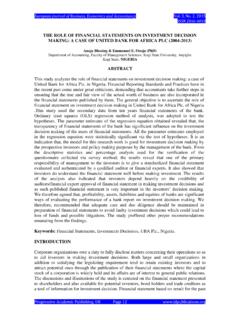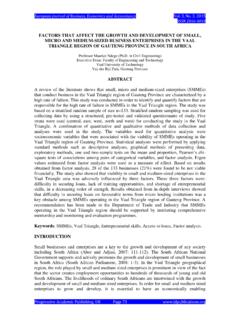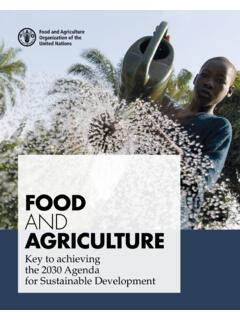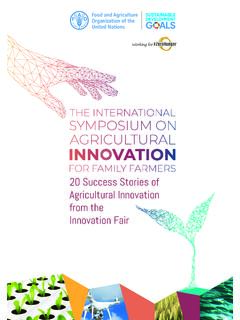Transcription of IMPACT OF ICTs ON AGRICULTURAL PRODUCTIVITY
1 European Journal of Business, Economics and Accountancy Vol. 4, No. 5, 2016 ISSN 2056-6018 Progressive Academic Publishing, UK Page 82 IMPACT OF icts ON AGRICULTURAL PRODUCTIVITY Syed Ali Urooj Afshan Jabeen Meela Nikhitha Associate Professor of Economics & Assistant Professor of Economics Student, (Hons) Economics Acting Dean, School of Social Sciences Government Degree College for with (Hons), Manufacturing Mulungushi University Women, Nalgonda Birla Institute of Technology & ZAMBIA INDIA Science, Pilani, Hyderabad INDIA ABSTRACT The study was conducted in Kapiri Mposhi district of Central Province in Zambia during June and August 2015.
2 The study used multiple stage random sampling technique to select the sample farmers. The objectives of this study were to find out the IMPACT of icts on AGRICULTURAL PRODUCTIVITY , net profit per acre and on sources of finance to the farmers. The study revealed that the IMPACT of icts on agriculture PRODUCTIVITY was positive. The IMPACT of television on PRODUCTIVITY was positive and statistically significant. The PRODUCTIVITY of farmers in the age group of 25-40 years was higher due to use of more icts . Estimation of the factors influencing PRODUCTIVITY and net profit involved the use of Ordinary Least Square Regression Techniques. The use of icts along with seed, fertiliser and amount borrowed on AGRICULTURAL PRODUCTIVITY was positive. The IMPACT of icts along with seed, fertiliser, amount borrowed and level of education on net profit per acre was also positive but statistically insignificant.
3 The study recommended that the Government should create an integrated AGRICULTURAL information system on agro-technologies and techniques, pricing and market information so that strategic information could be provided to farmers and other stakeholders at national , provincial and district levels. The study also suggested for development of ICT skills among AGRICULTURAL extension workers and farmers. Keywords: Radio, Television, Mobile phones, seed, fertiliser, PRODUCTIVITY , Net profit. INTRODUCTION Information and Communication Technologies ( icts ) are any devices, tools that permit the exchange or collection of data through interaction or transmission. ICT is an umbrella term that includes radio, television, mobile phone, internet, electronic money transfer, etc., The icts increase PRODUCTIVITY , access to markets and adaptability to weather conditions in agriculture.
4 More effective interventions are needed in agriculture because rising food prices pushed over 40 million people in to poverty since 2010 (World Bank 2011). The growing global population which is expected to reach 9 billion by 2050, has heightened the demand for food and placed pressure on already- resources. Feeding that population will require a 70 per cent increase in food production (FAO 2009). Even after years of industrialisation and growth in services, agriculture still accounts for one-third of the gross domestic product and three-quarter of employment in sub-Saharan Africa. Over 40 per cent of the labour force in countries with per capita incomes in the US$ 400 to 1,800 range works in agriculture (World Bank 2008). AGRICULTURAL PRODUCTIVITY rose around the world because more land was cultivated and more land was cultivated more intensively.
5 Most of the gains were made through intensification. AGRICULTURAL land expanded by only 11 per cent between 1961 and 2007 (FAO 2009), but between 1960 and 2000, genetic improvement and agronomic practices contributed to 78 European Journal of Business, Economics and Accountancy Vol. 4, No. 5, 2016 ISSN 2056-6018 Progressive Academic Publishing, UK Page 83 percent of the increase in production (Lal 2010). Bringing more land in to production is infeasible, not only because of the growing number of competing uses for land but because of environmental and social costs involved. The drive for AGRICULTURAL land has resulted in deforestation, reduced biodiversity and provoked other forms of environmental degradation (Balmford, Green and Scharleman 2005). It has also removed livelihood opportunities for some communities and elevated greenhouse gas emissions (Millennium Ecosystem Assessment 2005).
6 Due to these reasons there is need to raise crop yields without using additional land. Raising yield per unit of land was observed during the Green Revolution of 1960s and 1970s in Latin America and Asia. A similar Green Revolution never arrived in sub-Saharan Africa but is needed, given that almost all of the arable land is being cultivated (Govereh, Nyoro and Jayne 1999). Looking at the present global circumstances of PRODUCTIVITY gap and demand, there is need to increase the PRODUCTIVITY through intensive agriculture. The icts can play an important role in increasing the PRODUCTIVITY through intensive agriculture. Conducting IMPACT studies and sharing pilot project information is critical to success with icts as more specific lessons and impacts are learned (IICD 2006). Africa s arable land makes up to 40% of arable land globally, while only 10% is being cultivated (EIU 2012).
7 The share of agriculture in GDP in many African countries is much smaller, of ten 30% or less indicating low PRODUCTIVITY levels in the sector (AfDB, OECD, UNDP and UNECA 2012). A critical force in transforming agriculture in countries such as China and Korea was the investment in transport and communications infrastructure especially information and communication technologies, apart from their emphasis on AGRICULTURAL research and extension, irrigation systems and storage facilities which are essential factors for raising PRODUCTIVITY and increasing income for the poor (UNECA 2012). The strategic application of icts to the AGRICULTURAL sector, which is the largest economic sector in most African countries, offers the best opportunity for economic growth and poverty alleviation on the continent (World Bank, AfDB and AUC 2012).
8 Africa is the fastest growing region in the global telecommunications market. The number of mobile subscribers has further room for growth as Africa is being seen to have world s largest working-age population by 2040, which reflects the economic potential with a younger demography, of which 38% of the working youth in Africa are in the AGRICULTURAL sector (UNECA 2012). The national ICT Policy in Zambia recognizes that Agriculture is the economic backbone especially in rural areas. It plays an important role in the social and economic development of the country. Agriculture sector accounts for a significantly high proportion of the GDP and acts as the main source of employment and income in peri-urban and rural areas where the majority of Zambians reside. The national ICT s policy goal is to improve PRODUCTIVITY as well as competitiveness of the AGRICULTURAL sector through the use of icts in the planning, implementation, monitoring and the information delivery process (ZNFU 2016).
9 Agriculture is the major earner of export revenue in Zambia. In 2015, the value of agric exports was 27% of Non-Traditional Exports ( NTE) value and of the agric exports value 43% was maize (IAPRI 2016). In Zambia there are some studies concentrated on macro level on IMPACT of icts on agriculture. There is need for empirical studies at micro level on this subject. This study fills the gap in the existing literature on the IMPACT of icts on AGRICULTURAL PRODUCTIVITY selecting a district in the Central Province of Zambia. European Journal of Business, Economics and Accountancy Vol. 4, No. 5, 2016 ISSN 2056-6018 Progressive Academic Publishing, UK Page 84 Objectives of Study The specific objectives of this study are to: 1. Find out the different type of icts used by the farmers. 2. Examine the usage of icts in AGRICULTURAL activities 3. Know the IMPACT of icts , seed, fertiliser and the amount borrowed on production 4.
10 Investigate the IMPACT of icts , education, seed, fertiliser and amount borrowed on net benefit per acre. 5. Ascertain the distribution of production per acre according to gender, age and usage of icts . 6. Research the sources of finance to the farmers. LITERATURE REVIEW Mahmud and Ahsan (2016) studied the role of icts in Agriculture/Rural development and Governance in Taiwan. The study revealed that use of icts resulted in highest benefits to the producers and saved them from middlemen. icts were used for enhancing both research findings among the stake-holders which ensured optimum coordination between research and extension for the welfare of farmers. Chavula (2014) using the 2000-2011 panel data for 34 African countries revealed that icts played a significant role in enhancing AGRICULTURAL production, despite mobile phones had insignificant IMPACT while telephone main lines a significant contributor to AGRICULTURAL growth.

















